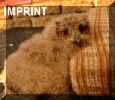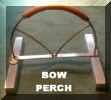ANKLETS -A cut piece of leather fastened around a raptors leg to which the jesses are attached. This enables the falconer to safely hold his bird.

AUSTRINGER - The name given to a falconer who flies true hawks.
AYLMERI -A raptors leather anklet with a brass eyelet for attaching the jesses.
BATE - When a raptor tries to fly from its perch or falconers fist when startled.
BAL-CHATRI -A trap used to catch raptors without hurting them.
BEAT - Using a stick to hit brambles, scrub etc. to flush quarry.
BEWIT - A thin piece of leather for attaching bells to a raptors leg.
BIND TO - When a bird of prey catches its quarry.
BOOSE - The place where a raptor drinks. This is where the expression 'Boozer' comes from.
BROADWING - The falconry name for buzzards, such as Common, Red-tailed and Ferruginous. Can also be used to describe Harris Hawks.
BUTEO - The Latin name used for true buzzards, such as Common Buzzard, Rough-legged Buzzard and Ferruginous Buzzard.
CAST - a/ To hold a bird round the body allowing furniture to be put on or for general health inspections etc.. b/ When a raptor regurgitates a pellet (a casting). c/ To fly two birds together, i.e. a pair of Harris Hawks.

CAST OFF - To allow a bird to fly from the fist.
CERE - The 'waxy' part at the top of a raptors beak that surrounds the nares or nostrils. Generally this is yellow in colour, but on a young falcon or adult Gyr the cere is blue.
CREANCE - The training line attaching raptor to falconer. Up to 50 feet in length.
CROP - A food storage sack before the raptors stomach. Absent from owls.
EYASS - A young hawk or falcon.
FALCON - a/ From the Latin Falx meaning sickle, in respect to the shape of a falcons talons. Term used for long narrow winged (longwing) raptors, such as Merlin, Kestrel etc. b/ The name for a female Peregrine.
FALCONER - Name for a person who flies long winged raptors (falcons). Nowadays generally used for all bird of prey fliers.
FED UP - An expression used to describe a falconry bird after it has eaten and refuses to do anything the falconer wants. This is where the expression 'fed up' comes from.
FEAKING - A raptor cleaning its beak by wiping it on a perch.
FLUSH - The word used to describe quarry breaking cover.
FOLLOWING ON - An expression used to describe a hawk following a falconer by flying from tree to tree. The aim of this is to have the hawk in a commanding position should quarry be flushed.
FOOTY - When a raptor tries to grab the falconers hand looking for food. Usually as a result of poor weight control.
FRET MARK - A line across a feather, usually caused by shock or stress during the moult.
HACK - A period at liberty for a bird before training starts. Not used so much today due to licensing laws. Young birds would be put into a tree nest, protected from predators and allowed to fledge. Food would be placed at the nest sight daily. When one of the birds made its first kill, all would be re-captured for training.
HACK BACK- To release a hawk (such as wild injured) back to the wild.
HAGGARD - The term for a wild caught adult hawk.
HARD PENNED - When new feathers are fully grown and the quills have hardened.
HAWK - The name for short-winged raptors such as Goshawk and Sparrowhawks (Accipter). Nowadays often used to describe buzzards.
HEDGE HUNTING - A style of hunting that requires the falconer, or companion, to beat along a hedgerow with the raptor either sat on the falconers glove, perched in a tree or waiting on above for quarry to be flushed.
IMP - To repair a broken feather with another.

IMPRINT - A bird that has been hand reared from a chick. Usually owls or small hawks.
INTERMEWED - The term for a raptor kept through a moult.
JACK - The name for a male Merlin.
JESSES - The name for the leather straps used to hold a hawk, falcon or owl.
JERKIN - A male Gyrfalcon.
LEASH - The lead used to tie a bird to the falconers glove or to the perch.
LONGWING - The falconry name for all true falcons, such as Merlin, Peregrine and Gyrfalcon.
LURE - In the case of falcons a dummy bird swung around the head. For hawks and owls a dummy bunny (rabbit) dragged along the ground. Both are used to teach the bird to hunt or to call a bird to the falconer.
MAIL - The breast plumage of a hawk.
MANNING - The process of taming a raptor.
MANTLE - A bird of prey covering its food with its wings and tail.
MEWS - The name for hawk/falcon housing.
MOULT - The annual shedding of old feathers and re-growing of new. This normally occurs during the warmer summer months. Traditionally a time when raptors are not flown as they are 'fed up' on extra rations to ensure healthy feathers.

MUSKET - The name for a male Sparrowhawk.
MUTES - Raptor droppings.
NAILED - The painful meeting of raptor talons and falconers flesh.
NARES - A raptors nostrils.
PASSAGE - An immature wild caught bird.
PERCH, BLOCK - A wooden perch used for falcons and owls.
PERCH, BOW - A semi-circular padded perch used for hawks, buzzards and eagles.
PITCH - a/ The maximum height a falcon reaches before stooping. b/ A trained bird of prey landing on the ground or in a tree.
QUARRY - Another name for prey.
QUARTERING - A slow, low hunting flight used over open land by such birds as Barn Owls or Marsh Harriers.
RAPTOR - From the Latin meaning 'to seize'.
RE-CYCLE - The term to describe a second or third clutch of eggs laid in one breeding season.
ROBIN - The name for a male Hobby. Thus is due to the rust red feathers on the lower abdomen.
ROUSE - The ruffling of feathers before flight or after a bath.

SHORTWING - The falconry name for all true hawks.
SOARING - A raptor using a thermal or up draft of air to aid flight.
SPAR - The name for a female Sparrowhawk.
STICKY FOOTED - The apparent inability of some raptors, ie Sparrowhawks and Ospreys, to release prey from their talons. In extreme cases, such as with Opsreys, this can prove fatal.
STILL HUNTING - A labour saving hunting technique employed by many birds of prey. This involves the bird sitting in a tree, or on some other high vantage point, awaiting prey to appear below. When it does the raptor simply pounces from its perch, thus saving the need for energy using flight.
STOOP - Diving a quarry from high in the sky. Typical of falcons.
SWIVEL - The figure of 8 piece of metal used to connect leash and jesses, preventing twisting.
TELEMETRY - Radio tracking device used for locating lost birds.
THROW UP - To sore skyward after a stoop.
TIERCEL- The name for a male Peregrine Falcon, now generally used for all male raptors. The word Tiercel has possible connections with the French word meaning one third. In the case of Peregrines the males are one third smaller than the females, hence Tiercel.
TIRING - A piece of meat used to keep a raptor busy without giving to much in food value.
TRAIN - The tail of a hawk.
WAITING ON - When a bird of prey reaches its pitch and awaits quarry to be flushed.
WASHED MEAT - Meat that has been soaked in water, allowing a bird to be fed up without putting on to much weight.
WEATHERING - An open area were raptors are kept on perches in good weather.
WILD INJURED - A term used to describe a wild bird of prey that has succumb to injury or disease and is being looked after by a qualified person before being returned to the wild. Any sick or injured bird found should be taken to the nearest vet and reported to the Department for the Environment, Food & Rural Affairs. www.defra.gov.uk/wildlife-countryside/citesbird/index.htm
NB. Chicks that appear to have fallen from a nest and look healthy should be left alone, the parents are ALWAYS near by ready to feed the youngster as soon as you have gone. If you are worried the chick may be eaten by a Fox etc, carefully place it onto a secure tree branch - and walk away.
YARAK - An expression used to describe a keen hawk. The feathers on the top and back of the head being raised slightly.